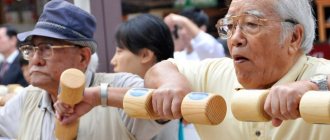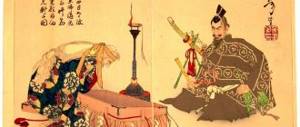Tatami is a traditional Japanese piece of furniture that has been used to cover floors in homes, temples, and official institutions since ancient times. The Japanese consider tatami to be an integral part of their home. In modern Japanese homes, tatami cannot be found everywhere, but in the homes of the Japanese, who adhere to the beliefs and culture of their country, such flooring is a must.
Tatami: educational program
This is a type of reed that is similar in structure to a sponge. This feature turned out to be indispensable in the difficult Japanese climate. The plant acts as a natural air conditioner: it absorbs and releases moisture when necessary.
Tatami is a mat consisting of three parts:
- The front part is dense, smooth and pleasant to the touch. It is woven from rushwood.
- Inner part. It is multi-layered and tightly woven from rice straw.
- Bottom part.
All components are elastic, so tatami is a good shock absorber. The product holds its shape and absorbs the impact when dropped. It has good thermal insulation properties, creating a feeling of comfort in cold and hot periods.
Due to the peculiarities of the weaving and its hygroscopicity, the coating does not burn well. A hot ember on the tatami surface will not light up, but will smolder for a long time.
What is a wrestling mat?
A wrestling mat (tatami) is a one-piece mat of a certain size, made without joints. Its soft surface has massage, bactericidal and hypoallergenic properties. It is also important that tatami mats are not prone to insects and mites.
The carpet is laid strictly according to established rules, which are determined by safety precautions. You cannot arrange them in the form of a lattice and allow the corners of three or four mats to touch at once. Otherwise, the coating may shift, move apart and lead to injury to athletes.
Story
Previously, straw was used to stuff Japanese mats. Nowadays, polystyrene foam is increasingly used, covering it with fabric.
About a thousand years ago, tatami mats were luxurious home decoration. Their importance was high because people of high rank sat on them: emperors, samurai, officials and respected persons. Initially, such bedding was called goza. They were pleasant to the touch because they were lined with silk. Many centuries later, when ordinary people began to use them, they began to cover the entire floor space with mats.
Although now this coating is not so popular in Japanese homes, it can still often be found among residents who honor traditions.
Density of wrestling mat
Another indicator that must be taken into account when choosing carpets is the density of the fillers. PPE tatami are divided into the following types:
- Standard-1, Standard-2, Master-1, Master-2 , with a density of 25 kg/m3, are suitable for regular training.
- Professional-1 has a density of approximately 33 kg/m3 and is mainly used for professional training and competitions.
- Professional-2 is a combined type of carpet that is in great demand as it is suitable for training at any level. It consists of PPE of different densities: on top and bottom there are layers of latex PPE (more rigid), and in the middle there is PPE with a density of 25 kg/m3.
Wrestling mats made of NPE with a thickness of 2-6 cm are also divided according to their indicators into:
- Soft, density 160 kg/m3.
- Average density - 180 kg/m3.
- Dense – 200–230 kg/m3.
Dense mats have high strength, durability and are more convenient to move on.
Tatami: the meaning of the word
Translated from Japanese it is “folding”. This is what "tatami" means.
Historians believe that the first tatami mats were thin and could be folded or rolled up.
Eastern countries are interesting for their reverent attitude towards traditions. Some do not go out of use for centuries, but live in families for thousands of years. This also applies to tatami.
Residents of Japan claim that if mats are placed incorrectly on the floor, it can attract trouble in the home. For example, the mats are not laid in a regular grid pattern on the floor so that the three or four corners of the tatami meet together. The significance of this is quite practical, since asymmetrically laid mattresses do not move or get knocked down, even if you actively move on them.
Such mats are not fixed to the floor in any way; they receive guests, sleep on them, and make podiums out of them.
History of tatami – made in Japan
Japan has a long tradition of cultural borrowing from China, but tatami is generally considered an original Japanese invention. The oldest tatami that has survived to this day dates back to the eighth century. It is kept in the Shosoin treasury of the Todaiji Temple in the city of Nara.
During the Heian era (794-1185), tatami mats were used in the residences of aristocratic families. If necessary, they covered individual areas of the floor and used them as seats or sleeping beds. For almost four centuries - from the end of the 12th to the middle of the 16th century - tatami became firmly established in everyday life; they began to cover the entire floor of living rooms. This is how they continue to be used to this day. By the middle of the Edo era, tatami had become a ubiquitous phenomenon among ordinary townspeople. And the province and rural areas were covered by "tatamization" during the Meiji era (1868-1912).
Application
The dimensions of the floor covering are strictly regulated. Rooms in Japanese houses are built in such a way as to fit the structure to the required number of tatami mats: from three to twelve pieces.
Housing is very expensive in Japan; it is noteworthy that advertisements for apartments for rent contain information about the number of mats. This is how the Japanese let you know about the area of the apartment.
What does tatami mean in the current understanding?
Standard dimensions are 0.9 by 1.8 m. The thickness of such a rug can reach six centimeters. With such dimensions, its weight can reach 30 kg. This is all due to the ability of the reed that fills the tatami to absorb moisture.
It is noteworthy that such a mat does not harbor harmful insects.
Traditional uses of tatami are:
- maximum expansion of room space;
- outlandish decor for a person of Western culture;
- eco-friendly living environment;
- comfort.
Such floor coverings are durable, but experts do not recommend wet cleaning of mats, as the filling can become moldy. It is better to use a vacuum cleaner and dry it in the fresh air in sunny weather every six months and turn it over the other side. Also, in Eastern culture, it is not customary to be on a mat with shoes on or with dirty feet.
Filling the fighting mat
The filler plays an important softening role as a shock absorber, so its qualities should ensure the safety of competitors. A wrestling mat with a polyethylene foam base is devoid of the disadvantages inherent in foam rubber mats. The material is not afraid of bends; water is much lighter than PVV. For tatami, such types of polyethylene foam are used as gas-filled non-crosslinked NPE brand and physically crosslinked PPE brand. Moreover, the second type of material is more popular. NPE mats do not contain allergens or substances hazardous to health, and their soft structure reduces the risk of injury during competitions.
Sport
In Western and domestic culture, the tatami is primarily a device that is used by schools teaching martial arts.
Tatami mats are quite hard as sports mats, so they are used carefully.
Not long ago, the UWW organization, which unites various types of martial arts, announced that the traditional tatami will change its colors. Red and yellow mats will be replaced by blue and orange ones.
This decision was made to improve the visual image of the broadcast of martial arts championships. The organizers also hope to attract new viewers. It was previously reported that the wrestlers' uniforms will be aimed at the youth segment.
Many martial arts have their own etiquette, inextricably linked with the thousand-year history of the existence of tatami, transferred to the sport from ordinary life. This is dictated not only by practical reasons, but also by tribute to the traditions of a great culture.
Wrestling mat coverings
Hygienic fabric is used to cover the wrestling mat using heat-pressing equipment. Its corners are welded by hand.
Cover the tatami as follows:
- The front (top) side is made of polyvinyl chloride fabric (PVC) or JUDO fabric with “rice straw” embossing.
- The bottom side is also made of PVC fabric or a special Anti-slip that does not allow the mats to slide during competitions.
In the center of the PVC fabric there is a reinforced mesh made of Mylar cord, which ensures a long service life of the coating.
Sumo fights
In historical times, fights between fighters were considered not sporting, but religious. They were always accompanied by various dances, singing or prayers. Such fights were held in Japan every year and were not limited by any rules. Only after some time was sumo recognized as a sport, and some rules were drawn up. Tournaments began to lose their religious theme and, thanks to the individual assistance of the emperor, sumo was not forgotten in the development of the sport, but developed into a form of martial arts. In other countries, a large number of people are fans of this type of martial arts.
Tatami mats used in sumo fights
Tatami are mats that make the battles of sumo fighters safer. In this sport, throws are often performed, which must be performed on the tatami in order to avoid serious damage. This type of tatami, the photo of which is shown above, is a specially designed mat for sumo wrestlers, which has a round shape, or a circle must be drawn on it, since the main task of a sumo wrestler is to force the opponent to touch with any part of the body the area outside the drawn circle.
How to choose a wrestling mat?
Any inventory loses its original characteristics over time. Therefore, when choosing a wrestling mat, first of all you need to know for what types of training it is being purchased. It is necessary to pay attention to the coating material, filler density, shock absorption ability and general safety indicators. Also, do not forget about the lightness and elasticity of the product to prevent creases and deformation.
The main task of a wrestling mat is to reduce the risk of injury to athletes during training and competitions. Before buying a tatami, you need to study both the external and internal parameters of the equipment. If you take the time to do this, you can purchase a high-quality wrestling mat that can last more than 10 years.
How to care for tatami?
In order for such equipment to last as long as possible, you must follow a few simple care rules.
- To avoid deformation of the products, you should not fold them, but it is recommended to carry them together, taking the tatami by the edges along the width.
- You can clean the coating with a washing vacuum cleaner or a damp cloth soaked in a detergent that does not contain chlorine.
- It is necessary to avoid temperature changes in the room where the tatami is stored, as well as during transportation. It is also better to protect products from direct sunlight, which can cause fading of the surface.
- Make sure that heavy furniture or sports equipment is not installed on the tatami for a long period of time - they can damage the coating and render it unusable.
- If classes are held in a room with high humidity, it is recommended to periodically ventilate the tatami.
Apartments as a designer
In traditional Japanese houses, each room can be a living room, a bedroom, or a study. And all because land in Japan is in great short supply and every meter is valued here. The furniture is made so that it can be easily folded and transported.
The size of the rooms can also be easily changed by rearranging the partitions. Large traditional houses often have only one large room under the roof, with the kitchen, bathroom and toilet located outside the house. In modern Japanese homes, you can often see sliding doors made of wood and paper, which can be easily removed. With the help of such partitions, you can easily turn one room into several if, for example, guests arrive. “The peculiarity of Japanese houses is that they have a reinforced floor structure that protects against the effects of earthquakes. This structure cannot be violated,” says Masako Sirota.
What types of sports mats are there?
Specialty coatings are divided into four main categories:
- Wrestling. Used for various types of martial arts and wrestling. The density of the filler is increased, the thickness ranges from 40 mm to 120 mm.
- Athletic. Used by acrobats and track and field athletes. The products are characterized by increased density and medium fullness. Thickness from 50 mm to 200 mm.
- Gymnastic. An integral attribute when doing aerobics, fitness, gymnastics. The thickness is 30 – 100 mm, the padding is medium density.
- Children's. Product thickness from 50 mm to 150 mm, with medium filler density. Popular models have bright colors, high-quality materials for manufacturing, excellent characteristics and a lot of other advantages. It is carefully tested for strength and functionality. They can be seen not only in martial arts halls, but also in rooms where there are free areas for play areas. Modern specimens are easily folded and stored in a secluded place for storage.
Plates can be both simple (single) and complex (folding). The latter are multi-sectional, which are joined together using a bending tape. Such structures can be easily transformed into large areas and used for sports activities by a group of people. When not needed, they can easily be stacked and stored away.
Six Japanese hundred parts
The Japanese have a great interest in natural materials that are not harmful to health. Thus, they prefer wooden floors in their homes, plaster is applied to the walls, and furniture made of oak or walnut is valued. Gardens near the house are at a special price.
“The plot on which our house stands is 30 meters wide and 60 meters long. By our standards, this is a large garden! – says Hiromi Ito. She lives with her parents and sister in the countryside, 6 hours from Tokyo. “We even grow vegetables - depending on the season, these are carrots, cabbage, kohlrabi, etc., and, of course, flowers. Behind the garden are rice fields. It’s nice to live when there is so much greenery around, where there is somewhere to walk,” continues Hiromi.
Houses in a Japanese village are like toys: there is no foundation in our understanding, strong walls and a reliable roof. A traditional Japanese house is a structure made of wooden columns and a roof. This is done in case of an earthquake. The roof is wide, protects from the sun, and if everything collapses, you can quickly put it back together. The walls are almost all made of movable panels - you get a wall, a door, and a window. Only one wall is solid.









